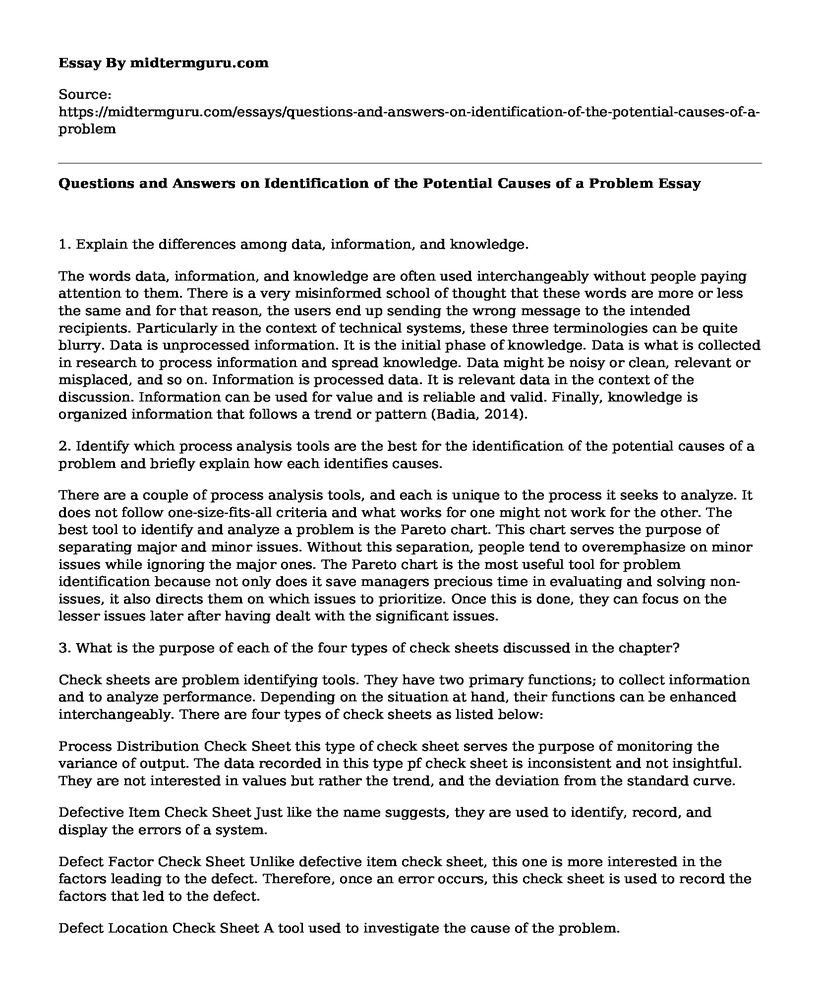1. Explain the differences among data, information, and knowledge.
The words data, information, and knowledge are often used interchangeably without people paying attention to them. There is a very misinformed school of thought that these words are more or less the same and for that reason, the users end up sending the wrong message to the intended recipients. Particularly in the context of technical systems, these three terminologies can be quite blurry. Data is unprocessed information. It is the initial phase of knowledge. Data is what is collected in research to process information and spread knowledge. Data might be noisy or clean, relevant or misplaced, and so on. Information is processed data. It is relevant data in the context of the discussion. Information can be used for value and is reliable and valid. Finally, knowledge is organized information that follows a trend or pattern (Badia, 2014).
2. Identify which process analysis tools are the best for the identification of the potential causes of a problem and briefly explain how each identifies causes.
There are a couple of process analysis tools, and each is unique to the process it seeks to analyze. It does not follow one-size-fits-all criteria and what works for one might not work for the other. The best tool to identify and analyze a problem is the Pareto chart. This chart serves the purpose of separating major and minor issues. Without this separation, people tend to overemphasize on minor issues while ignoring the major ones. The Pareto chart is the most useful tool for problem identification because not only does it save managers precious time in evaluating and solving non-issues, it also directs them on which issues to prioritize. Once this is done, they can focus on the lesser issues later after having dealt with the significant issues.
3. What is the purpose of each of the four types of check sheets discussed in the chapter?
Check sheets are problem identifying tools. They have two primary functions; to collect information and to analyze performance. Depending on the situation at hand, their functions can be enhanced interchangeably. There are four types of check sheets as listed below:
Process Distribution Check Sheet this type of check sheet serves the purpose of monitoring the variance of output. The data recorded in this type pf check sheet is inconsistent and not insightful. They are not interested in values but rather the trend, and the deviation from the standard curve.
Defective Item Check Sheet Just like the name suggests, they are used to identify, record, and display the errors of a system.
Defect Factor Check Sheet Unlike defective item check sheet, this one is more interested in the factors leading to the defect. Therefore, once an error occurs, this check sheet is used to record the factors that led to the defect.
Defect Location Check Sheet A tool used to investigate the cause of the problem.
4. What are the five most commonly cited leading causes of problems? Include at least two sub-causes for each primary reason.
The major causes are: People/manpower, Supplies/materials, Equipment/machines, Environment/mother nature, Process/method (Componation, & Farrington, 2000).
Under supplies as a major problem cause, we have the sub-causes such as design whereby the supplies are not suitable for use and inferior materials that are poor quality. Under machines/equipment, there are sub-causes such as appropriateness whereby the device are not designed for the process, and outdated tools that may prove ineffective.
Reference
Badia, A. (2014). Data, information, knowledge: An information science analysis. Journal of the Association for Information Science and Technology, 65(6), 1279-1287. http://dx.doi.org/10.1002/asi.23043Componation, P., & Farrington, P. (2000). Identification of Effective Problem-Solving Tools to Support Continuous Process Improvement Teams. Engineering Management Journal, 12(1), 23-30. http://dx.doi.org/10.1080/10429247.2000.11415060
Cite this page
Questions and Answers on Identification of the Potential Causes of a Problem. (2021, Jul 01). Retrieved from https://midtermguru.com/essays/questions-and-answers-on-identification-of-the-potential-causes-of-a-problem
If you are the original author of this essay and no longer wish to have it published on the midtermguru.com website, please click below to request its removal:
- Haraways Cyborg Theory and Digital Communication Technologies
- Paper Example on Network Security Issues with Wireless Technology
- Research Paper on Cybersecurity
- The Awareness of Password in Organization for Security Purpose: Research Proposal
- Internet Banking - Essay Sample
- FDA AERS: Outcome of Adverse Event Reports - Essay Sample
- Digital Market Plan: Leveraging Microcomputers' Life Cycle - Essay Sample







